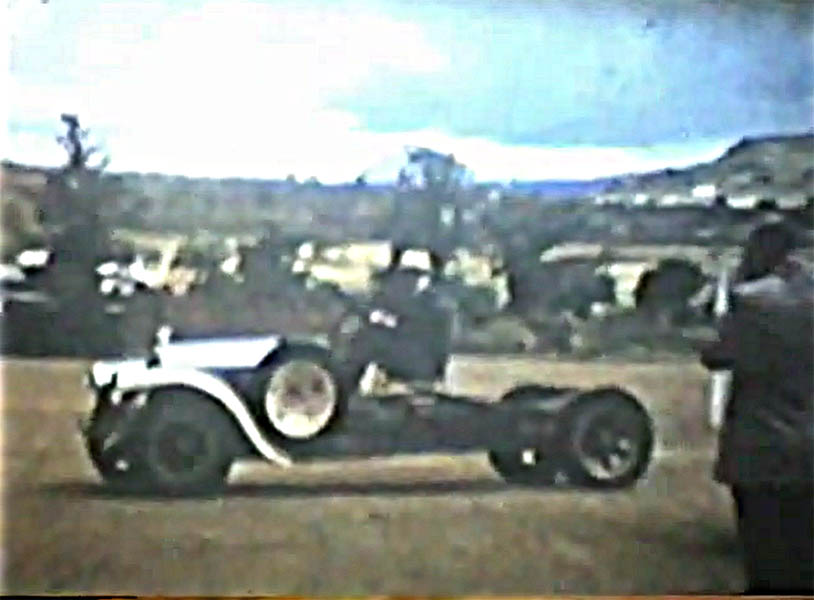Tracing a Rolls Royce - last seen half-a-century ago.
|
This web page started out as an effort to trace the original background of an unusual Rolls Royce Silver Ghost,
and if possible what happened to it after it was last seen by me some time in the 1950s.
Through the efforts of a number of correspondents around the world, much more is now known about this vehicle, both about its origins and its current whereabouts. This web-page has accordingly been updated for those who would like to know "the rest of the story". Further increments to information may be seen by visiting the following links
|
Why is this information being sought? The search started mainly to satisfy the simple curiosity of a number of alums from the school in Kenya where this vehicle saw service as the school bus. It would be nice to be able to confirm what is factual about its alleged history as well as where it eventually ended up. Since then, further interest has been shown by other enthusiasts around the world, particulalrly in the light of its obviously chequered history and the stories (legends?) surrounding its provenance.
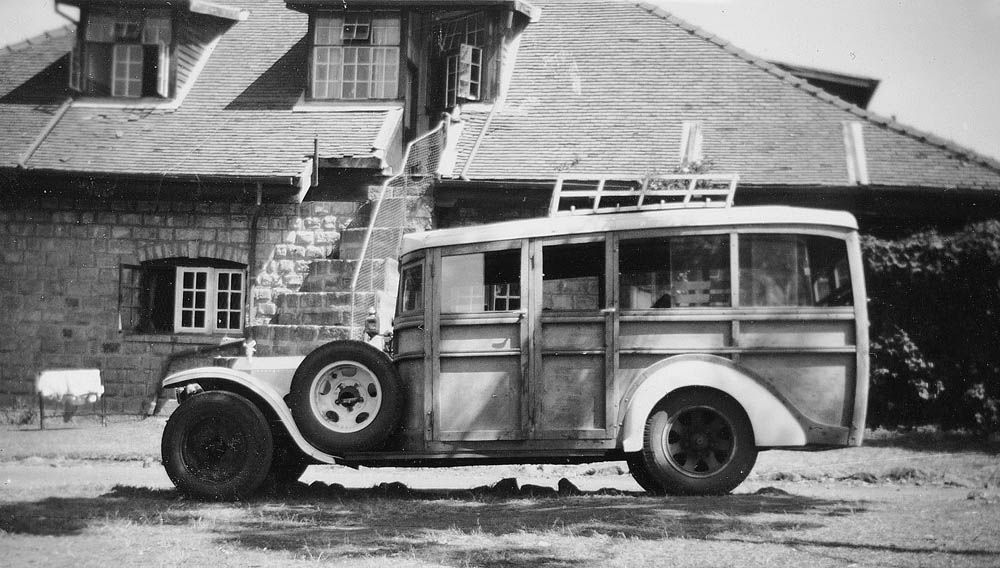
|
| Picture 1 |
The History - what was known for sure
This vehicle first appears on the Register of Motor Vehicles in Kenya around 1930,* [Correction - information received many years after this web-page was first created shows that it was imported from Britain shortly after WWII - probably in 1949]
It was known to be in Kenya until around 1959. During the last part of this era at least, it was owned by Chris Hazard, the headmaster and owner of a private boarding school called "Pembroke House" which was located on the edge of the Great Rift Valley in a small place called Gilgil. At that time it was a boys-only school with 70 or 80 pupils, ages 8 through 12. More can be learned about this school at https://pembrokehouse.sc.ke.
This vehicle functioned as "The School Bus". When soccer or cricket matches were arranged with other boy's schools in Kenya, this was the conveyance which took the team on safari to play the "away" matches. In 1957 * the "boxbody" superstructure was removed, and the operating "rolling chassis" raffled off for about £400 to raise funds to build a school chapel.
* Subsequent (Feb 2011) clarification from an ex-pupil who actually helped prepare the Rolls for auction, established this date as being in the first half of 1959 or possibly toward the end of 1958. I am also indebted to this former pupil for contributing pictures 3 and 4 below - he took these with his Box Brownie 620.
The raffle winner then sold the vehicle on to an automobile enthusiast by the name of Major Curtis, and The Bus thus found a new home at a place called Kampi ya Moto, also in Kenya.
That is about all that is known as an absolute fact.
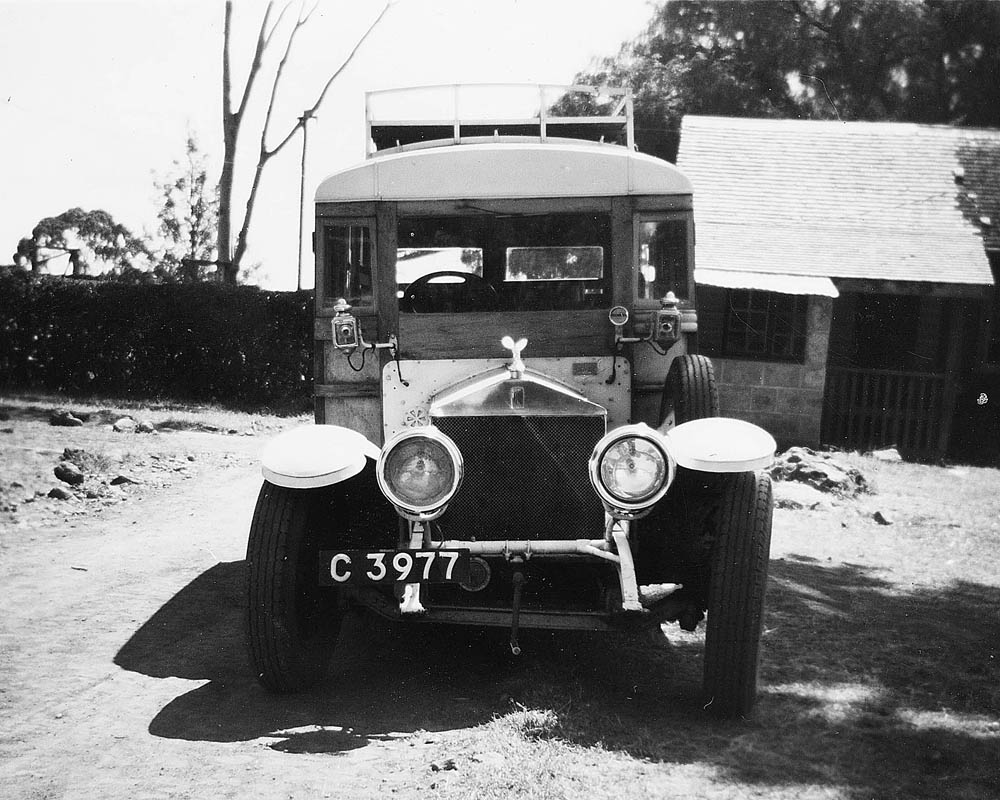
|
| Picture 2 |
Prior History - the handed-down story
Chris Hazard, the headmaster of Pembroke House School and the owner of this Rolls, was a bit of an eccentric (i.e. a real "character") and would occasionaly regale the pupils at the school with stories. Some were obviously fairy tales, others very "real life". My memory isn't 100% accurate, after half a century, but I remember that when he was questioned on the origin of the Rolls, he told something like the follwing:The vehicle was initially intended to fill an order placed by an Indian Maharajah at the Rolls Royce factory, some time prior to the outbreak of the First World War in 1914. Around the time that the chassis had been laid but the coach work not yet completed, the vehicle was commandeered by the British Ministry of Defense and finished off as an armoured car.
Although many vehicles in armoured car configuration remained in service until at least 1939, it is thought that 'The Bus' was decommissioned sometime around 1927 and a new 'shooting brake' body built in place of the earlier armament and shipped to Kenya for use by the then Prince of Wales, later King Edward VIII, during his extensive safari in Kenya.
|
This piece of the story about the Rolls being reconstituted as a safari vehicle for the Prince of Wales has since been
shown to be apocryphal. An email was received in August 2012 with information that would appear to clearly refute
this part of the story.
Further discussion on this piece of the tale may be found here. |
It subsequently remained in the Colony OHMS (On His Majesty's Service) before being retired from public service and being privately registered for the first time in Kenya as C 3977, sometime in the early 1930's. This bears out chronologically. Regrettably, records at the Kenya Registrar of Motor Vehicles are not what they might be, but a search is being attempted with assistance from the Vintage & Classic Car Club of Kenya in the hope of uncovering more about this vehicle and, hopefully, where she ended up.
Chris Hazard subsequently "acquired" the vehicle as payment of a debt, and that is (allegedly) the story of how this vehicle ended up as the school bus at Pembroke House. It is not known in what year it arrived there - only that it was definitely there during my tenure at the school (1950-1954) and until it was "retired" and raffled off as a fund-raiser in 1959.
The following two pictures show the bus after its body was removed prior to it being raffled off.
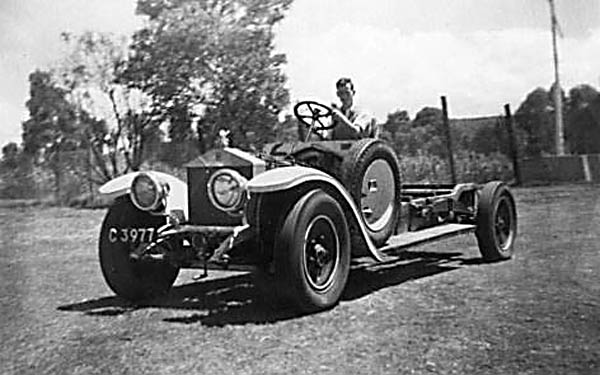
|
| Picture 3 |
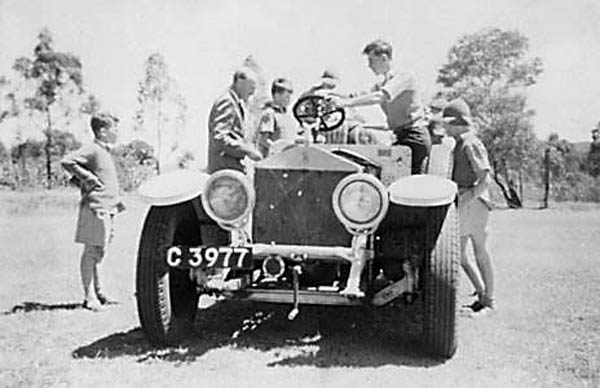
|
| Picture 4 |
In the last picture above, Chris Hazard is the gentleman on the left of the vehicle.
Next to him and and holding on to the steering wheel is another schoolmaster, Brian "Harpic" Hanbury, maths teacher, pianist and gifted cartoonist. He is also sitting in the driver's seat in the previous picture.
Others in the picture are pupils at Pembroke House.
So far, these are the only known pictures of the bus - although others may surface in due course.
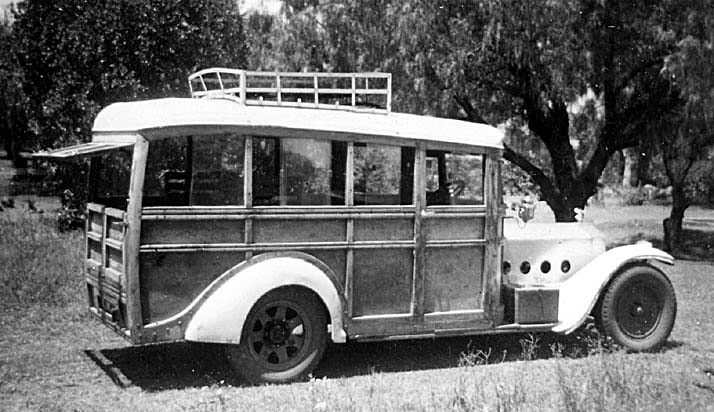 |
| This picture was brought to my attention in January 2008 - courtesy of John Pembridge (PH 1952) |
| Picture 5 |
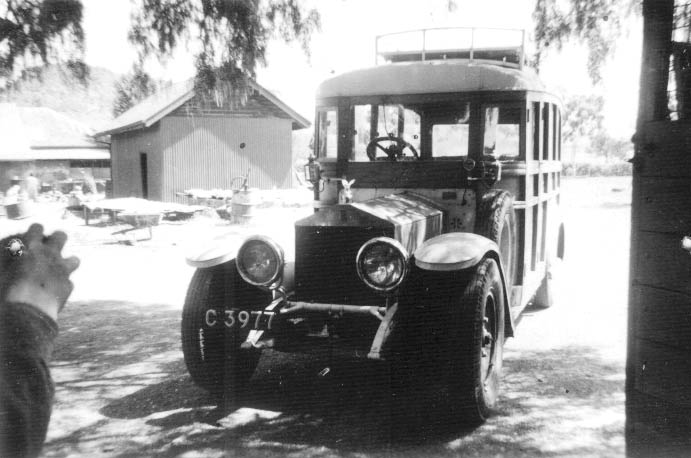 |
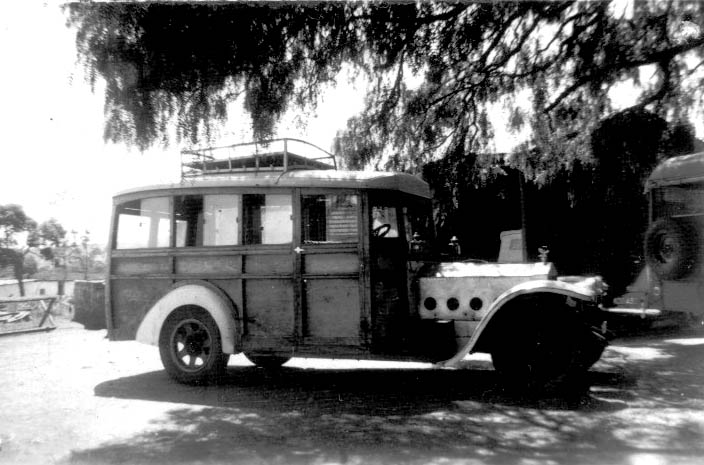 |
| Another two pictures were brought to my attention in May 2011 - courtesy of Roger Morrall (PH 1953) |
| Pictures 6 & 7 |
Some clues that may help to confirm or deny the earlier history
The Wheels
At first sight, the presence of steel wheels on a vehicle of WW1 vintage would appear to be an anomaly. There are two possible explanations for these:- If the story about the origins as an armoured car is true, then the presence of steel wheels fits the facts. It is known that Rolls Royce fitted steel wheels (and even double wheels on the rear axle) on the armoured cars in order to be able to handle the considerable extra weight of the armoured body.
- I can remember some wooden-spoked wheels on a junk pile at the school, and maybe Chris Hazard abandoned these original wheels and replaced them with some truck wheels as a reliability measure when the vehicle started its life as a school bus. On the other hand, those wooden wheels on the junk pile might have come from any vehicle. Many American vehicles were imported into Kenya prior to World War II (Model T, Hupmobile, Terraplane) and maintenance headaches with wooden-spokes would have been a real problem in that environment. Consequently it would not be unusual to replace such wheels when steel substitutes later became available - and the ones I saw might have come from any vehicle.
(A correspondent informs me that the wheels shown appear to be American in origin and from around 1930. They were probably fitted because it was easier to obtain tyres for such wheels rather than the original British rims, especialy true in the immediate aftermath of WWII)
The Fenders (Mudguards)
The front fenders are clearly Rolls Royce. Even if the armoured cars did not sport such fenders (not clear from the few pictures available on the web) then these fenders might have been fitted in England when the vehicle was converted into a shooting brake for the Prince of Wales' safari to Kenya. ( That is assuming that that part of the history is true)But the rear fenders are less clear-cut. In general they appear to "match the style" of the front fenders, but as we can see in Picture (3) above, they were associated more with the body than the chassis. Maybe we can conclude that whoever made the body also provided the rear fenders? If so, then again there are two possibilities:
- If the story about the origins as an armoured car is true, and the "conversion" from armoured car to shooting brake occurred in England, then it would not be unnatural for matching Rolls Royce-styled fenders to be used in the conversion - the armoured cars did not appear to have rear fenders like these.
- If the shooting brake body (known also as a "boxbody") was built in Kenya, it is unlikely that such fenders with their compound curves could have been manufactured locally. At best they would have to have been "borrowed" from some other vehicle. So an interesting question is whether the rear fenders are genuine Rolls Royce or some ersatz replacement.
(A correspondent informs me that these "fenders" were almost certainly cannibalized from a truck of about 1940-1950 vintage)
The Starting Mechanism
One aspect that can help date a Rolls Royce of the era in question is the presence or absence of an electric starter.This vehicle definitely did not have an electric starter as we know them today. However, it did not rely completely on the hand crank at the front - sometimes. As I remember it, starting the beast involved a fairly complex ritual. First the oil pressure would be pumped up via a small manually operated brass piston located on the floor near the driver's feet. After vigorous pumping, one person would then very gently apply one or two cranks to the handle at the front, while a second person prepared to manipulate one of two brass levers mounted on the hub of the steering wheel. One of these levers traveled over an etched plate labelled "Advance/Retard", the other one I can't remember for sure, but I think was labelled "Throttle".
(Subsequent note - I have since been informed by people more knowledgeable on the matter that this was not to bring the oil pressure up. In fact this is an air pump. On the side of the gear box was a small pump with a pencil-size bore which pumped air into the fuel tank to give a pressure of about 4 lbs/sq in. Being able to start the engine you pumped 1 lb of pressure into the tank by the hand pump to fill the carb.)
After these first tentative cranks, the person cranking would stand clear, and the person at the wheel would then jiggle one of these brass levers. Most of the time nothing at all would happen, but very occasionally, the engine would cough into life.
(A correspondent informs me that this was a known technique, but frowned upon by the factory. The jiggling of the advance/retard lever could cause a spark in the ignition if the main shaft was fortuitously positioned. This spark in one cylinder could cause a violent "crank", sufficient to get the engine going, but placed undue stress on the motor components)
If it didn't start, this was occasion for the muttering a very special oath. (It was not deemed seemly for the Headmaster of of a school populated by little boys to actually use real swearwords). On cool days, the word was "Machakos" - in fact a totally innocuous expletive which happened to be the name of a town not too far from Nairobi, the capital of Kenya. On at least two other occasions however, the normaly impeccably-behaved headmaster was heard to utter the infamous "F" word followed by an extremely rapid recovery, so that it came out something like "Faaah...kedit". We never did forget it however, it was imprinted on our minds for all time.
The next part of the starting ritual was a rolling up of the sleeves, a few more pumps on the oil-pressure, and a vigorous crank of the handle at the front. Usually after a few such attempts, the motor would struggle into life (with further judicious jiggling of the levers on the steering wheel as soon as it coughed) and the sports team was instructed to mount the bus in preparation for another safari to a competing school.
The fuel pump (if there was one - it might have had a gravity feed for fuel) was also not up to handling maximum power on steep hills. Occasionally such a safari involved negotiating the steep escarpment of the Great Rift Valley. One particular stretch of this journey was accomplished in reverse - both because this asssured a better fuel supply, and reverse gear had the lowest ratio.
The Body As A Whole
At first sight, the body does not appear to have the quality appearance of (for example) something by Mulliner Park Ward. Indeed it looks quite frumpy, and has a certain air of "built by some well-meaning amateur" about it.However, the roof is made of metal (probably supported by an interior wooden infrastructure - I can't remember) and is clearly "fitted" with moderately complex compound curves. Again, it is extremely unlikely that the skills or equipment to manufacture such a roof existed in Kenya at that time. The colony was blessed with many skilled craftsmen (such as carpenters) whose families originated in India and who were imported to build the railroad. Thus the woodwork on the body was well within the capabilities of local manufacture in Kenya - but the metal roof is highly doubtfull. That would imply that the roof came from England - and because the wooden part of the body clearly is "matched" with the roof, then probably that too.
That in turn implies that maybe the bodywork on this vehicle was not a complete "one off" but that maybe similar (slightly different but with familial resemblance) vehicles may have been built by Rolls Royce and its coach-builders.
An alternate legend surfaces about the origins. WWI Ambulance.
Inquiries in Kenya surfaced a slightly different handed-down story about the origins of the vehicle. In this it was told the the bus had originally belonged to the Duke of Westminster, and had seen service during the First World War as an ambulance at the Somme.An apparent contradiction - but also electrifying to those who know the history of Rolls Royce vehicles in The Great War.
The keywords "WW1", "Rolls Royce", and "Duke of Westminster" point almost conclusively to "armored car".
The Duke of Westminster just happens to be the individual most associated with Rolls Royce armoured cars in WW1. In fact it was he who formed "The Duke of Westminster's Armoured Car Squadron" and gave it his name. The story can be found in a book by S.C.Rolls (no relation to the Rolls family) who was a driver in this unit. The book is called "Steel Chariots in The Desert" and "...is The Story of an Armoured Car Driver with the Duke of Westminster in Libya and in Arabia with T.E.Lawrence..." A blurb about the book reads
So while this alternate legend seemed to contradict that of the Rolls' origins as an armoured car, it also served to strengthen it. Maybe both legends got somewhat garbled in the retelling, but common elements seemed to offer a tantalizing glimpse of a romantic history for the vehicle. Having two independent sources whose stories intersected in such a curious way gave added impetus to the hunt for the real facts.STEEL CHARIOTS IN THE DESERT. The Story of an Armoured-Car Driver with the Duke of Westminster in Libya and in Arabia with T.E. LAWRENCE; by Lt.-Col. Eric Barrass. Initially published by Jonathan Cape 1937, subsequently re-published 1988 in a facsimile edition by RREC Publishing, the Rolls-Royce Enthusiasts Club.
"Great was Rolls, and great was Royce! They were worth hundreds of men to us in these deserts." -- T.E. Lawrence.
The mention of "Rolls" in the quote refers to the author of this book. It was this Rolls who was personal driver of the legendary "Lawrence of Arabia" throughout what are widely regarded as some of the most romantic and brilliant campaigns of the First World War. Sam Cottington Rolls, a qualified motor mechanic, volunteered his services to the newly formed Duke Westminster's Armoured Car Squadron. So strange then was the use of any sort of motor vehicles in the armed services, that the Squadron was part of the still fledgling Royal Naval Air Service. Initially the author saw service in France, ferrying "brass-hats" to forward positions are Ypres; soon transferring to the army to join a new Brigade of armored cars that was to demonstrate its special skills and attributes in trackless desert conditions. Sam Rolls provides eye witness accounts of such as the desert rescue of the survivors of the British ship the Tara from the Senusites; and Lawrence "sawing" a wooden plank with revolver shots to help repair his stricken Rolls-Royce. Readers are made aware of the almost magical charisma radiated by Lawrence and how it inspired British and Arab alike
The Dénouement
The publishing of the intial version of this web-page, and a series of emails sent to potentially interested parties around the world, resulted in a number of interesting responses with further clues. These then triggered further e-mail exchanges.Then suddenly, within the space of a few hours, several independent messages arrived from expert sources who had managed to identify the vehicle, and thus help locate its details in the archives. The consolidation of the history that surfaced contains two major gaps - the era that took the Rolls from Britain to Kenya, and subsequently the era that brought it back to Britain again. However, by linking the elements based on the chassis and engine numbers as well as other facts, the known pieces of the history can be pieced together.
The known history in summary:
- The car is a Silver Ghost built in 1913 with chassis number 2495 and engine number 79G. It is finished with
with a Landaulette body by Cockshoot of Manchester.
- The first owner was Mrs Holden of Hurst Dene, Hale, Cheshire.
- In 1916 a note in the factory records says that a letter to Mrs Holden was returned, marked "gone away".
- In 1920 the second owner was noted as Mrs Harry Lomax (her daughter) of Westwood, Park Road, Hale. (Just as an aside - a recent (Feb 2011) correspondent informs me that Mr. Harry Lomax,
son-in-law of Mrs Holden, and subsequently
living at Westwood Park Road, also in Hale, Cheshire, purchased a new Rolls-Royce 20HP Silver Ghost in September 1927, and took delivery of his new car in January 1928. That particular car
is now in The Netherlands, it is a ¾ doctor coupe with body by Cockshoot.)
- The trail goes cold
- Around 1930, the vehicle is registered in Kenya with the plate "C 3977"
* However - a subsequent discovery (in April 2020) raises some doubt about this alleged occurrence in 1930. A descendant of R. Strevens (see mis-spelled name in next entry) sent me an extract from his Father's Memoirs which tell us that the vehicle was bought in London and shipped to Kenya soon after WWII for use as a farm vehicle on a farm near Nakuru. This extract is reproduced and can be seen on this page.
- In 1949 it was noted that the owner was R Stevens of P.O. Nakuru, Kenya. *(Should be R. Strevens)
- In 1950 a change of ownership was noted to C.M. Hazard of Pembroke House, Gilgil, Kenya.
- In 1959 it was raffled off and subsequently bought from the winner (a Mr. W. Dale) by Major Courtney Curtis of Kampi Ya Moto, Kenya.
During Major Curtis' ownership the car was fitted with a
tourer body built by Casini & Tonolo of Nairobi , a picture of which is known to exist.
- Around 1970 the car was offered to a Kenyan car enthusiast for £3500, however he was unable to finance this purchase.
- The trail goes cold again.
- In 1972 the car re-appears in Britain with R.N.E. Prosser of Kent noted as the owner, and about that time a new body was built for it by Wilkinsons of Derby, after
the style of a "Roi de Belges" Tourer. Apparently he owned it until 1974.
- Subsequently it changed hands again to a new owner in South Wales.
(Pictures may be seen here) It was later learned that this owner passed away in June 2017.
The status or subsequent disposition of the car after this was unknown for a few years.
- In April of 2021 an email was received from the new owner who lives in Germany. He sent a picture of the old bus in its new environment which may be seen here.
Jitze Couperus
jitze,couperus@gmail.com
